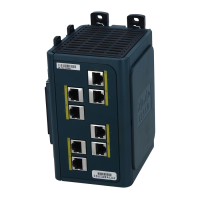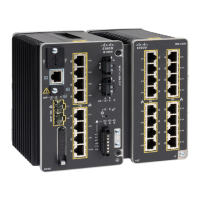633
Configuring QoS
Configuring QoS
After you have created the hierarchical output policy map, you attach it to an egress port. See Attaching a Traffic Policy
to an Interface, page 609.
Use the no form of the appropriate command to delete an existing hierarchical policy map, to delete a port shaping
configuration, or to remove the policy map from the hierarchical policy map.
This example shows how to configure port shaping by configuring a hierarchical policy map that shapes a port to 90
Mbps, allocated according to the out-policy policy map configured in the previous example.
Switch(config)# policy-map out-policy-parent
Switch(config-pmap)# class class-default
Switch(config-pmap-c)# shape average 90000000
Switch(config-pmap-c)# service-policy out-policy
Switch(config-pmap-c)# exit
Switch(config-pmap)# exit
Switch(config)# interface fastethernet0/1
Switch(config-if)# service-policy output out-policy-parent
Switch(config-if)# exit
Configuring Output Policy Maps with Class-Based Priority Queuing
You can use the priority policy-map class configuration command to ensure that a particular class of traffic is given
preferential treatment. With strict priority queuing, the priority queue is constantly serviced; all packets in the queue are
scheduled and sent until the queue is empty. Excessive use of the priority queues can possibly delay packets in other
queues and create unnecessary congestion.
You can configure strict priority queuing (priority without police), or you can configure an unconditional priority policer
(priority with police). Follow these guidelines when configuring priority queuing:
You can associate the priority command with a single unique class for all attached output policies on the switch.
When you configure a traffic class as a priority queue, you can configure only police and queue-limit as other
queuing actions for the same class. You cannot configure bandwidth or shape average with priority queues in the
same class.
You cannot associate the priority command with the class-default of the output policy map.
Configuring Priority Without Police
Follow these guidelines when configuring strict priority queuing (priority without police):
5. service-policy policy-map-name Specify the child policy-map to be used in the hierarchical policy
map if required.
6. exit Return to policy-map configuration mode.
7. exit Return to global configuration mode.
8. interface interface-id Enter interface configuration mode for the interface to which you
want to attach the policy.
9. service-policy output policy-map-name Attach the parent policy map (created in Step 2) to the egress
interface.
10. end Return to privileged EXEC mode.
11. show policy-map [policy-map-name [class
class-map-name]]
Verify your entries.
12. copy running-config startup-config (Optional) Save your entries in the configuration file.
Command Purpose
